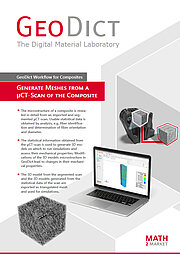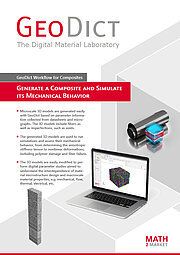Composites
The challenge: Combining fibers, matrix polymers, and fillers so that their strengths complement each other and their weaknesses are balanced out.
Composite materials are crucial to improve the functionality and lightweight design for current component development. No longer limited to the aerospace industry, they are widely used in civil aviation, transportation, construction, and widespread in engineering.
Steady technical progress and the increasing number of application areas call for competitive and reasonably-priced design of materials with very high stiffness and strength, coupled with a low as possible material density.
- Easy generation of realistic, digital models of fiber structures
- Identification of individual fibers from a µCT-scan and accurate analysis of the fiber diameter distribution, fiber orientation, and fiber length distribution (for short fibers)
- Identification of pores (voids) from a µCT-scan and precise analysis of their size, shape, and distribution
- Prediction of the permeability of a reinforcing textile, even in the compacted state
- Fast determination of the anisotropic stiffness tensor
- Simulation of large deformations including plasticity, damage and failure
- Prediction of electrical and thermal conductivity
- Export of structures easily generated within GeoDict as a mesh for use in further analysis with other FE solvers
Analyze and understand mechanical properties, properties linked to the geometry, and other physical properties of the material (e.g. fabrics, semi-finished products, or polymers) at the microscale. Optimize the properties based on the quantitative and qualitative results of simulations.
With GeoDict, Math2Market offers the complete solution for digital materials research and development.
The GeoDict Solution for Development of Composites
In addition to GeoDict Base, the GeoDict package for Digital Materials R&D includes all necessary modules for the research and development of composites.
Module Recommendations
| Image Processing and Image Analysis | ImportGeo-Vol | |||||
| Material Analysis | GrainFind-AI | FiberFind-AI | PoroDict + MatDict | |||
| Modeling & Design | GrainGeo | FiberGeo | GrainFind-AI | WeaveGeo | ||
| Simulation & Prediction | DiffuDict | ConductoDict | FlowDict | ElastoDict | AddiDict | SatuDict |
Suitable modules depend on the concrete application.



















